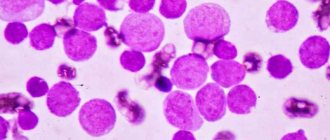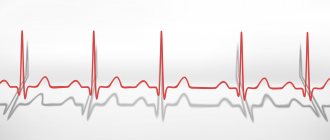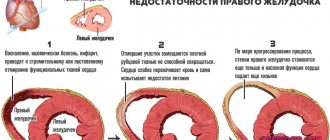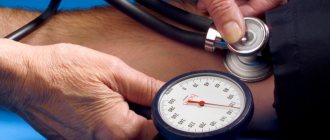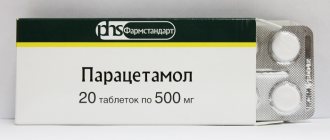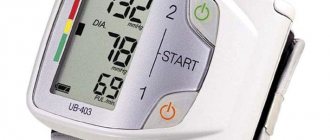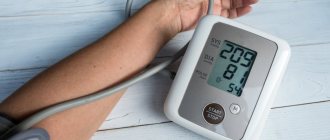Cardiovascular diseases are the leading cause of death among the working population. Modern medicine has already studied these pathologies well. There are many treatment methods to prevent heart attacks and strokes, even if there is a hereditary tendency to them.
To avoid death and the consequences of advanced heart disease, every adult should be able to understand the readings of a tonometer and know what a pressure of 120 over 70 means.
What does pressure 120 over 70 mean?
Normal blood pressure is considered to be 120 over 70 and 120 over 80, but these numbers are arbitrary. For some people, a blood pressure of 125 over 75 may also be normal, but for others it may be a critical level. Blood pressure indicators are influenced by many different factors, ranging from the characteristics of the body to various diseases.
Schematic representation of blood movement at systolic (left) and diastolic (right) pressure
Below we will look at what the numbers 120 to 70 mean:
- Systolic (upper). A reading of 120 is the upper blood pressure. It is recorded at the moment when the heart contracts for the subsequent release of blood.
- Diastolic (lower). In this case, the number is 70. The indicator is recorded at the moment when the heart expels blood and returns to a state of rest.
Note. In order for the tonometer to show the most accurate data, it is necessary to measure the pressure while sitting. The hand should lie motionless, in a horizontal position. A person’s emotional state plays a huge role. Blood pressure is measured only in a state of complete calm.
Normal or pathological?
Doctors emphasize that there is no single standard for blood pressure: for each person it depends on the physiological characteristics of the body. The only criterion that determines normal blood pressure is a person’s general well-being. Therefore, blood pressure 120/80 or blood pressure 120/70 is an individual norm for adults, regardless of gender and age, which corresponds to WHO recommendations.
Despite the fact that blood pressure is an individual value, it depends on some fundamental factors:
- the speed at which the myocardium contracts;
- the volume of blood pumped by the heart over a certain time;
- resistance of vascular walls.
We can talk about normal blood pressure if these three indicators are stable. In this case, the person feels healthy, the heart beats smoothly, and breathing is free. There are no negative symptoms. In general, normal blood pressure can range from 100/60 to 140/90.
Reasons for changes in blood pressure
The main reason for surges in blood pressure is poor functioning of the vascular system. The definition of “poor performance” refers to the inability of blood vessels to adapt to a particular environment, which subsequently leads to changes in blood pressure. There are many factors influencing changes in indicators:
- Depending on the time of day, as well as the age of the person;
- Alcohol and tobacco abuse;
- Often, blood pressure changes after drinking coffee, strong tea or using any medication;
- Blood pressure is also affected by a person’s physical and/or emotional state;
- Often indicators change after watching TV shows of an alarming nature;
- An increase in blood pressure can occur due to various diseases, for example, disruption of the endocrine system and adrenal glands, diseases of the genitourinary system and the musculoskeletal system. Often blood pressure increases due to problems with the gastrointestinal tract, cardiovascular system, vegetative-vascular dystonia and many other ailments;
- Also, changes in indicators are often recorded after visiting a solarium, because UV radiation has a detrimental effect on the heart and blood vessels;
- Many people are very sensitive to weather conditions. In most cases, blood pressure changes due to sudden changes in weather, including atmospheric pressure;
- If you eat improperly, you may become overweight, blockage of blood vessels with cholesterol plaques, and worsen the functioning of the cardiovascular system. All these factors contribute to sharp increases in blood pressure.
Preventive actions
Young people usually do not need treatment with such pressure levels, but at the same time, in older people it is extremely necessary. Primarily due to the risk of developing such serious complications as angina, stroke, encephalopathy, myocardial infarction.
Start with lifestyle changes:
- Normalization of daily routine and rest.
- Good sleep and nutrition.
- Adequate physical activity.
- Hardening.
- Avoid stressful situations.
- Swimming and water procedures.
- Taking herbal tinctures that increase immunity (preferably after consultation with a doctor).
In children, blood pressure and pulse rates differ from adults:
- newborn baby - pressure 70 mmHg. and pulse 140 beats per minute;
- for a one-year-old child, blood pressure 95/65 pulse 100 beats;
- at 10 years of age 100/70 and pulse 80;
- teenage girls blood pressure – 115 per 70 pulse 70;
- for teenage boys, the numbers are close to age norms of 120 to 70 and the average heart rate is about 70-75.
The need to know this information lies in the peace of mind of parents, who may accidentally mistake this indicator for a pathology.
Important! A pulse value of 120 beats per minute occurs in patients of all ages and gender. It is necessary to pay attention to this indicator when measuring blood pressure.
Diseases of the cardiovascular system occupy a leading position in mortality and primary disability. The problem is associated with late appointments with a therapist and ignoring the first manifestations of heart and vascular diseases. However, such a pathology is easier to prevent than to treat. It is necessary to listen to your body every day and understand the reasons for the disruption of its normal functioning. Diseases associated with abnormal blood pressure and pulse levels can be diagnosed long before the first complaints appear and timely treatment can begin. This is facilitated by a healthy lifestyle, proper nutrition and adequate rest, moderate physical activity, as well as regular monitoring of blood pressure and pulse. If there is any change, you should not rush to see a doctor; changes in several dimensions should cause alarm. If there is no result from the non-drug correction described above, contact a medical facility. The reason for going to an appointment may be “normal” measurement indicators if you are feeling poorly in general, provided that you do not know your own indicators. Don't ignore your health, take care of it today.
The value of a person’s blood pressure indicates the pressure with which the blood acts on the arterial walls. But why does the tonometer show 2 numbers? They indicate 2 cardiac phases - pumping and rest. These phases are called systole and diastole, and alternate regularly. First, the heart pumps blood into the bloodstream. This phase is displayed on the tonometer as systolic (upper) pressure, higher. In the second phase, the heart is at rest, not pumping blood. At this stage, the diastolic indicator, determined by the resistance of the vascular bed, is measured. Diastolic pressure is the smaller number, the lower one. What values are normal? What does it mean if the pressure measured is 120 over 70? Read below.
Possible symptoms
If this pressure is normal for a person, then no unwanted symptoms are observed. If the pressure of 120 to 70 is not typical for a person, then it is possible that ailments such as:
- Frequent dizziness;
- In some cases, fainting occurs;
- Constant fatigue;
- General weakness of the body;
- Increased pulse pressure;
- There is often a headache and tinnitus.
Note. If symptoms appear, you should not use self-prescribed medications. Especially medications for low or high blood pressure. This can significantly worsen the condition and lead to serious consequences. Any medications should be used only after the approval of a doctor.
Change in heart rate
The normal heart rate for a healthy person is 60-80 beats per minute. An increased pulse is defined as tachycardia. As a rule, this disease is accompanied by:
- Trembling of fingers;
- Hyperemia (overflow of blood vessels);
- Excessive excitement;
- Often the sick person can feel the pulse beat in the ears.
In most cases, all these symptoms occur when the pulse pressure increases to 90 units.
When your blood pressure changes, pay attention to your pulse. This will help you diagnose your condition
In case of bradycardia (less than 60 beats per minute), the following are noted:
- Drowsiness and feeling of fatigue;
- Depressed and apathetic state;
- Pallor of the skin;
- Sometimes blue lips.
Headache with blood pressure 120 over 70
Headaches are common to those people for whom this pressure is not normal. Depending on the type of illness, the nature and area of pain may vary:
- The cause of a headache with a pressure of 120 over 70 in hypotensive patients may be insufficient oxygen supply to the brain cells. The pain is aching in nature, and is localized in the back of the head and temples.
- In hypertensive patients, headaches can occur due to vasospasm and circulatory disorders. In this case, the pain sensations are characterized as shooting or aching, and their localization area is the back of the head, forehead, and often the pain radiates to the bridge of the nose.
Important! Headaches due to hypertension should never be ignored. This disease may indicate a serious circulatory disorder, which subsequently provokes the occurrence of diseases such as heart attack or stroke.
Why does my head hurt?
With a slight deviation of blood pressure readings from the norm by 15-20 units, hypotensive patients often complain of headaches and dizziness. If the pressure “jumps” a little in hypertensive patients, they also indicate discomfort, but they are quickly eliminated when blood pressure decreases. Patients usually describe a girdling headache that is aching and continuous. Sometimes a burning sensation appears in the back of the head and temples.
In case of normotension with excess of the permissible heart rate, headache can be a sign of:
- Neuralgia.
- Dorsopathies in the cervical spine.
- Infectious syndrome in any part of the body.
- Traumatic brain injuries.
- Allergic manifestations.
- Intracranial hypertension (impaired intracranial metabolic processes, consequences of neuroinfections, failure of fluid circulation in the spine).
- Cluster headaches (characterized by high intensity, most often appear in the eye area).
Such conditions have pronounced symptoms, from which a specialist will be able to accurately determine the developing pathology.
Important! The manifested pain syndrome is often the root cause leading to an attack of hypertension.
Headaches that are not associated with any disease are noted:
- Eating large amounts of food or drinking too cold in hot weather.
- The presence of monosodium glutamate in food in large quantities.
- Headaches resulting from overwork, tension, and emotional states.
In this case, it is necessary to be examined by a doctor to establish an accurate diagnosis and, if necessary, undergo a course of treatment.
Blood pressure in pregnant women
In most cases, pregnant women experience an increase in blood pressure by 10-20 units, sometimes perhaps up to 30. Therefore, indicators of 120 over 70 are considered low, but they do not always indicate that a serious pathology has appeared. Such jumps in blood pressure are explained by physiological changes in the body during pregnancy.
During pregnancy, pay special attention to blood pressure, as this can affect the health of the unborn baby.
If the expectant mother feels well at a given blood pressure and the risk of developing fetal hypoxia is not diagnosed, then there is no particular cause for concern. But if in doubt, you can consult your gynecologist, who monitors the course of the pregnancy.
Surgery
IT IS IMPORTANT TO KNOW!
In 90-95% of people, high blood pressure develops regardless of lifestyle, being a risk factor for diseases of the brain, kidneys, heart, vision, AS WELL AS HEART ATTACKS AND STROKES! In 2020, scientists discovered a relationship between the mechanisms of increasing blood pressure and blood clotting factor. Read more "
If medications do not have a positive result, attacks of low blood pressure become more frequent, and symptoms appear in the form of loss of consciousness, then extreme measures must be taken. Pacemakers are used to normalize cardiac function. This device can only be installed surgically by inserting it into the heart muscles. The device provides the necessary rhythm of contractions, the organ works at the required frequency.

